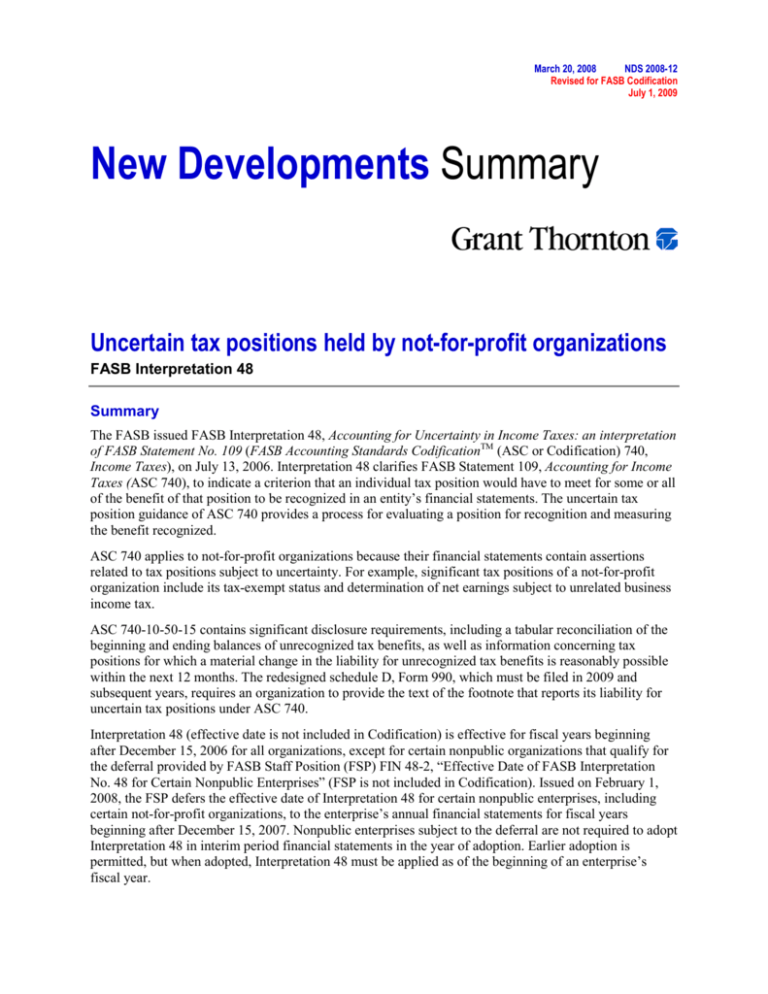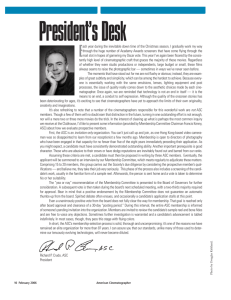
March 20, 2008
NDS 2008-12
Revised for FASB Codification
July 1, 2009
New Developments Summary
Uncertain tax positions held by not-for-profit organizations
FASB Interpretation 48
Summary
The FASB issued FASB Interpretation 48, Accounting for Uncertainty in Income Taxes: an interpretation
of FASB Statement No. 109 (FASB Accounting Standards CodificationTM (ASC or Codification) 740,
Income Taxes), on July 13, 2006. Interpretation 48 clarifies FASB Statement 109, Accounting for Income
Taxes (ASC 740), to indicate a criterion that an individual tax position would have to meet for some or all
of the benefit of that position to be recognized in an entity’s financial statements. The uncertain tax
position guidance of ASC 740 provides a process for evaluating a position for recognition and measuring
the benefit recognized.
ASC 740 applies to not-for-profit organizations because their financial statements contain assertions
related to tax positions subject to uncertainty. For example, significant tax positions of a not-for-profit
organization include its tax-exempt status and determination of net earnings subject to unrelated business
income tax.
ASC 740-10-50-15 contains significant disclosure requirements, including a tabular reconciliation of the
beginning and ending balances of unrecognized tax benefits, as well as information concerning tax
positions for which a material change in the liability for unrecognized tax benefits is reasonably possible
within the next 12 months. The redesigned schedule D, Form 990, which must be filed in 2009 and
subsequent years, requires an organization to provide the text of the footnote that reports its liability for
uncertain tax positions under ASC 740.
Interpretation 48 (effective date is not included in Codification) is effective for fiscal years beginning
after December 15, 2006 for all organizations, except for certain nonpublic organizations that qualify for
the deferral provided by FASB Staff Position (FSP) FIN 48-2, “Effective Date of FASB Interpretation
No. 48 for Certain Nonpublic Enterprises” (FSP is not included in Codification). Issued on February 1,
2008, the FSP defers the effective date of Interpretation 48 for certain nonpublic enterprises, including
certain not-for-profit organizations, to the enterprise’s annual financial statements for fiscal years
beginning after December 15, 2007. Nonpublic enterprises subject to the deferral are not required to adopt
Interpretation 48 in interim period financial statements in the year of adoption. Earlier adoption is
permitted, but when adopted, Interpretation 48 must be applied as of the beginning of an enterprise’s
fiscal year.
Grant Thornton LLP
2
Contents
A. Introduction ............................................................................................................................................ 2
B. Scope ...................................................................................................................................................... 2
C. Recognition and measurement ............................................................................................................... 3
Classification ................................................................................................................................... 3
D. Common tax positions of a not-for-profit organization.......................................................................... 3
Tax-exempt status ............................................................................................................................ 3
Unrelated business income .............................................................................................................. 4
E. Subsequent accounting ........................................................................................................................... 5
Derecognition................................................................................................................................... 5
Change in judgment ......................................................................................................................... 5
Interest and penalties........................................................................................................................ 5
F. Disclosures ............................................................................................................................................. 5
G. Effective date and transition (not included in Codification) .................................................................. 6
Definition of a nonpublic enterprise ................................................................................................ 7
A. Introduction
The FASB issued FASB Interpretation 48, Accounting for Uncertainty in Income Taxes: an interpretation
of FASB Statement No. 109 (FASB Accounting Standards CodificationTM (ASC or Codification) 740,
Income Taxes), on July 13, 2006. Interpretation 48 clarifies FASB Statement 109, Accounting for Income
Taxes (ASC 740), by indicating a criterion that an individual tax position must satisfy for an entity to
recognize some or all of the benefits of that position in its financial statements.
This bulletin provides an overview of the uncertain tax position guidance of ASC 740 and highlights
some application issues unique to not-for-profit organizations. Additional guidance on the provisions of
the uncertain tax position provisions of ASC 740 may be found in NDS 2006-39, “Accounting for
uncertainty in income taxes,” and NDS 2007-23, “Settlement of uncertain tax positions.”
B. Scope
The scope of ASC 740 is broad. Besides business enterprises, it applies to not-for-profit organizations,
pass-through entities, and entities whose tax liability is subject to a 100 percent credit for dividends paid,
such as real estate investment trusts. Additionally, the scope of the uncertain tax provision guidance of
ASC 740 includes all tax positions accounted for in accordance with ASC 740.
The term tax position (ASC Glossary) includes, but is not limited to, the following:
•
A decision not to file a tax return in a jurisdiction
•
The allocation of income between jurisdictions
•
The characterization of income or a decision to exclude reporting taxable income in a tax return
•
A decision to classify a transaction, entity, or other position in a tax return as tax exempt
Grant Thornton LLP
3
C. Recognition and measurement
In applying the uncertain tax position guidance of ASC 740, a not-for-profit organization is required to
evaluate each tax position individually using a two-step process.
First, the organization must evaluate the position for recognition. An organization should recognize the
financial statement benefit of a tax position if it determines that it is more-likely-than-not that the position
will be sustained on examination. The term more-likely-than-not means a likelihood of more than 50
percent. In assessing whether the more-likely-than-not criterion is met, an organization should assume
that the tax position will be reviewed by the applicable taxing authority. Additionally, if past
administrative practices and precedents of the taxing authority are widely understood, those practices and
precedents should be considered in an organization’s assessment of the more-likely-than-not criterion. For
instance, if an organization decides not to file Form 990-T or a tax return in a state where it has certain
business dealings, that decision must be evaluated under the uncertain tax position provisions of ASC
740. If the organization’s position does not meet the more-likely-than-not threshold, it must record a
liability measured according to the ASC 740’s requirements.
Second, the organization should measure the amount of benefit that should be recognized for tax positions
that meet the more-likely-than-not test. The amount recognized should be the largest benefit that has a
greater than 50 percent likelihood of being realized upon effective settlement. For instance, suppose an
organization’s management estimates the amounts and probabilities of possible outcomes of a tax position
that meets the more-likely-than-not criterion as shown in the following table. Because $50 is the largest
benefit that has a greater than 50 percent likelihood of being realized upon ultimate settlement, the
organization would realize a $50 benefit in its financial statements.
Possible Estimated
Outcomes
Individual Probability of
Occurring
Cumulative Probability of
Occurring
$75
20%
20%
$50
35%
55%
$20
45%
100%
Classification
If the organization issues a classified statement of financial position, the liability resulting from the
difference between the tax return position and the amount recognized and measured under the uncertain
tax position guidance of ASC 740 should be classified as current for those amounts anticipated to be paid
within one year or, if longer, within the operating cycle. Unless that liability arises from a taxable
temporary difference created by a tax position that meets the more-likely-than-not recognition threshold,
it should not be classified as a deferred tax liability.
D. Common tax positions of a not-for-profit organization
Tax-exempt status
A not-for-profit organization’s most significant tax position may be its assertion that it is exempt from
income taxes. The organization should evaluate its tax-exempt status in each applicable jurisdiction—
Grant Thornton LLP
4
federal, state, local, and foreign—based on the facts, circumstances, and information available at the
financial statement reporting date. For the period presented in the financial statements, the organization
must determine if it is more-likely-than-not that a tax examination would sustain its tax-exempt status.
For example, the Internal Revenue Service (IRS) determines if an organization is exempt from federal
income taxes based on specific criteria in the Internal Revenue Code (IRC), including the organization’s
purpose and the nature of its activities and support. The IRS also has the authority to revoke an
organization’s exemption retroactively. Matters that could affect an organization’s federal tax-exempt
status include, but are not limited to, the following:
•
Material organizational changes: Changes in the organization’s character, purpose, or method of
operations
•
Private benefits: The provision of substantial monetary or nonmonetary benefits to the private interest
of any individual or organization
•
Private inurement: The receipt of any of the exempt organization’s income or inappropriate use of the
organization’s assets for personal gain by an insider, such as an officer, director, key employee, or
substantial contributor to the organization. Neither private benefit nor private inurement (which is
considered a type of private benefit) includes the payment of reasonable salaries or the provision of
services to individuals as part of an organization’s exempt-function activities.
•
Lobbying: Activity to influence legislation
•
Political campaign activity: Direct or indirect support for, or opposition to, a candidate for elective
office
•
Unrelated business activity: Substantial unrelated business activities compared to the organization’s
tax-exempt activities.
•
Violation of public policy.
For tax years beginning after December 31, 2006, if an organization is required to file an information
return or annual electronic notice and fails to do so for three consecutive years, it will lose its tax-exempt
status as of the filing due date of the third year.
Unrelated business income
Under the IRC, an unrelated trade or business of a tax-exempt organization is any trade or business,
regularly carried on, whose conduct is not substantially related to the exercise or performance of the
organization’s exempt purpose. ASC 740 applies to a not-for-profit organization’s tax position with
respect to taxes on income from an unrelated trade or business, including the organization’s assertions as
to
•
Which of its activities and income are not subject to unrelated business income tax
•
Whether an expense is deductible from unrelated business revenue in arriving at net taxable income
Under ASC 740, an organization should evaluate each of its income-producing activities to determine
whether a tax examination would more-likely-than-not determine that the transactions associated with the
activity are tax exempt. For unrelated business activities, the determination of taxable income and the
deductibility of expenses should also be evaluated.
Grant Thornton LLP
5
E. Subsequent accounting
A tax position that did not originally meet the more-likely-than-not recognition threshold would be
recognized in a later period if any of the following conditions is met:
•
The organization concludes that the more-likely-than-not threshold has been met.
•
The statute of limitations for examination and challenge of the related tax position expires.
•
The organization resolves the matter with the taxing authority through negotiation or litigation. ASC
740-10-25-10 (FASB Staff Position (FSP) FIN 48-1, “Definition of Settlement in FASB
Interpretation No. 48”), establishes the conditions that must be met for the matter to be considered
resolved by effective settlement upon examination by a tax authority.
Derecognition
A previously recognized tax position should be derecognized if the organization concludes in a later
reporting period that it is no longer more-likely-than-not that the position will be sustained on audit.
Change in judgment
The only changes in judgment that should result in changes in the recognition, measurement, or both of a
tax position are those resulting from the evaluation of new information. A change in the recognition,
derecognition, or measurement of a tax position taken in a prior annual period should be recognized
entirely in the interim period in which the change in judgment occurs. Changes in judgment related to
positions taken in a prior interim period within the same fiscal year should be reflected in the calculation
of the estimated annual effective tax rate.
Interest and penalties
If the applicable tax law requires an organization to pay interest on the underpayment of income taxes,
interest should be accrued on the difference between the tax benefit recognized in the financial statements
and the amount claimed or expected to be claimed in the tax return. Similarly, if a statutory penalty would
apply to a particular tax position, a liability for that penalty should be recognized in the period the
organization takes, or expects to take, the position in its tax return. Organizations have accounting policy
choices to classify interest as income tax expense or interest expense, and penalties as income tax expense
or another expense classification.
F. Disclosures
Under ASC 740-10-50-19, an organization should disclose its policy on the income statement
classification of interest and penalties.
ASC 740-10-50-15 also requires an organization to make the following disclosures at the end of each
annual reporting period:
•
A tabular reconciliation of the beginning and ending balances of unrecognized tax benefits.
Disclosure is required of the following reconciling items:
−
Gross amount of increases in unrecognized tax benefits resulting from
Grant Thornton LLP
−
−
Current period tax positions
Prior period tax positions
6
Gross amount of decreases in unrecognized tax benefits resulting from
Current period tax positions
Prior period tax positions
Decreases in unrecognized tax benefits resulting from
Settlements with taxing authorities
Lapses in the applicable statute of limitations
•
Information concerning tax positions for which a material change in the liability for unrecognized tax
benefits is reasonably possible in the next 12 months
•
The total amount of unrecognized tax benefits that, if recognized, would impact the effective tax rate
•
The total amount of interest and penalties recognized in the income statement and in the balance sheet
•
Open tax years by major jurisdictions
ASC 740 disclosures and Form 990
The redesigned Form 990, Schedule D, to be filed in 2009 and subsequent years, will
require an organization to provide the text of the footnote that reports the organization’s
liability for uncertain tax positions under ASC 740.
G. Effective date and transition (not included in Codification)
The cumulative effect, if any, of applying the provisions of Interpretation 48 to all tax positions upon
initial adoption of the Interpretation should be presented separately, as an adjustment to the opening
balance of net assets in the statement of financial position for that fiscal year.
Interpretation 48 is effective for fiscal years beginning after December 15, 2006 for all organizations,
except for certain nonpublic organizations that qualify for the deferral provided by FSP FIN 48-2,
“Effective Date of FASB Interpretation No. 48 for Certain Nonpublic Enterprises.”
Issued on February 1, 2008, FSP FIN 48-2 defers the effective date of Interpretation 48 to the enterprise’s
annual financial statements for fiscal years beginning after December 15, 2007 for a nonpublic enterprise
that has not issued a full set of annual financial statements reflecting the recognition, measurement, and
disclosure provisions of the Interpretation before the FSP was issued. Nonpublic enterprises subject to the
deferral are not required to adopt Interpretation 48 in interim period financial statements in the year of
adoption. Earlier adoption is permitted, but when adopted, Interpretation 48 must be applied as of the
beginning of an enterprise’s fiscal year.
A nonpublic enterprise that issued financial statements reflecting the adoption of the recognition,
measurement, and disclosure provisions of Interpretation 48 before the FSP was issued is not eligible for
Grant Thornton LLP
7
the deferral and must continue to apply Interpretation 48. Subsidiaries of public enterprises are not
eligible for the deferral for their stand-alone financial statements.
Definition of a nonpublic enterprise
The term enterprise, as used in Statement 109, Interpretation 48 (the term entity has replaced enterprise in
the Codification), and FSP FIN 48-2, refers to both not-for-profit organizations and for-profit entities.
Only a nonpublic enterprise, as defined in the ASC Glossary, may be eligible for the deferral of
Interpretation 48 provided by FSP FIN 48-2. The ASC Glossary defines nonpublic enterprise as follows:
An enterprise other than one (a) whose debt or equity securities are traded in a public
market, including those traded on a stock exchange or in the over-the-counter market
(including securities quoted only locally or regionally), (b) that is a conduit bond obligor
for conduit debt securities that are traded in a public market (a domestic or foreign stock
exchange or an over-the-counter market, including local or regional markets), or (c)
whose financial statements are filed with a regulatory agency in preparation for the sale
of any class of securities.
Conduit debt securities refers to certain limited-obligation revenue bonds, certificates of
participation, or similar debt instruments issued by a state or local governmental entity
for the express purpose of providing financing for a specific third party (the conduit bond
obligor) that is not a part of the state or local government’s financial reporting entity.
Although conduit debt securities bear the name of the governmental entity that issues
them, the governmental entity often has no obligation for such debt beyond the resources
provided by a lease or loan agreement with the third party on whose behalf the securities
are issued. Further, the conduit bond obligor is responsible for any future financial
reporting requirements.
Therefore, the deferral does not apply to a conduit bond obligor for conduit debt securities that are traded
in a public market (a domestic or foreign stock exchange or an over-the-counter market, including local or
regional markets).
© 2008 Grant Thornton LLP, U.S. Member of Grant Thornton International Ltd. All rights reserved.
This Grant Thornton LLP bulletin provides information and comments on current accounting and tax
issues and developments. It is not a comprehensive analysis of the subject matter covered and is not
intended to provide accounting, tax, or other advice or guidance with respect to the matters addressed in
the document. All relevant facts and circumstances, including the pertinent authoritative literature, need to
be considered to arrive at conclusions that comply with matters addressed in this bulletin.
Moreover, nothing herein shall be construed as imposing a limitation on any person from disclosing the
tax treatment or tax structure of any matter addressed herein. To the extent this bulletin may be
considered to contain written tax advice, any written advice contained in, forwarded with, or attached to
this bulletin is not intended by Grant Thornton to be used, and cannot be used, by any person for the
purpose of avoiding penalties that may be imposed under the Internal Revenue Code.
For additional information on topics covered in this bulletin, contact your Grant Thornton LLP adviser.





